Bulletin – October 2005 Recent Trends in World Saving and Investment Patterns[1]
The external current account positions of major countries and regions around the world have recently changed substantially. The current account deficit in the US has doubled as a share of GDP over the past five years, current account surpluses have increased in other major developed countries, and surpluses instead of persistent deficits are now regularly recorded in East Asia and virtually every other emerging market region. This situation has generated substantial discussion on the causes of these recent movements and how best to address them.[2] This article outlines the changes in the national saving and investment patterns that underpin these developments, and reviews the outlook for the current pattern and level of international financial flows.
World Current Account Trends
For much of the past two decades, most major countries and geographic regions showed either persistent surpluses or persistent deficits in their current accounts. Specifically, from the early 1980s to the mid 1990s, the US and other developed English-speaking countries recorded current account deficits that averaged around 2½ per cent of GDP. Every emerging market region – east Asia, Latin America, the Middle East, Eastern Europe, and the former Soviet Union – also recorded ongoing current account deficits during this period. The counterparts to these deficits were surpluses in Japan and, to a lesser extent, in the developed European countries (Graph 1). This pattern in world financial flows reflected structural and economic features facing different countries, including: the relatively rapid ageing of the population in Japan and Europe, which encouraged high levels of net saving; comparatively strong economic performance in developed English-speaking countries in the 1990s, which offered a high real rate of return on investment; and the young workforces and low capital-to-labour ratios in the emerging market economies, which encouraged capital inflow into those economies.
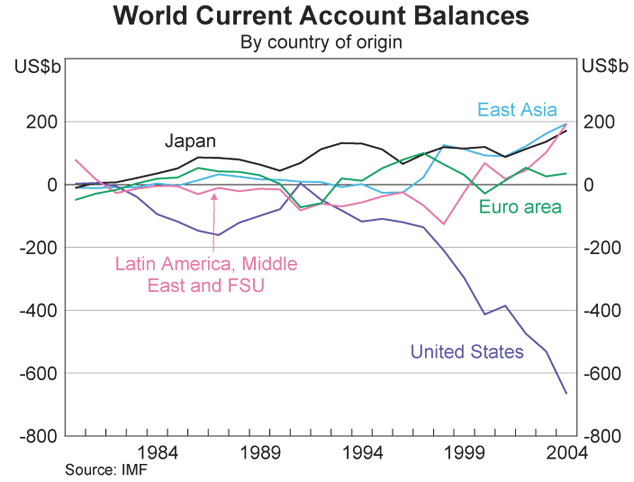
Since the late 1990s, these traditional current account patterns have changed. In the developed countries, the current account deficit in the US has doubled, to reach almost 6 per cent of GDP in 2004 (US$668 billion), and the current account surpluses in Japan and some other developed countries have increased. In addition, a growing number of countries and developing regions have switched from being net absorbers of world saving to being persistent net suppliers: China since 1994, the other east Asia region since 1998, the oil producers in the Middle East plus Russia since 1999, and Latin America since 2003. Indeed, in contrast to most of the period under review here, by 2004 the Eastern Europe and former Soviet Union (excluding Russia) region was the only developing area that still had a current account deficit (Table 1).[3] As a consequence, in addition to Japan and developed European countries, significant net saving contributions now also come from the Middle East and Russia, China and other east Asia countries.
| 1997 | 2004 | Change | |
|---|---|---|---|
| United States | −141 | −668 | −527 |
| Anglo area (excluding US) | −28 | −65 | −37 |
| Euro area | 96 | 47 | −49 |
| Japan | 97 | 172 | 75 |
| China | 34 | 69 | 35 |
| Rest of Asia | −21 | 115 | 136 |
| Western Hemisphere | −67 | 18 | 85 |
| Eastern Europe & FSU(a) | −27 | −47 | −20 |
| Middle East & Russia | 8 | 163 | 155 |
| Other (inc non-euro Europe) | 36 | 111 | 75 |
| Memo: World Imbalance | −14 | −86 | −72 |
|
(a) Excludes Russia Source: IMF |
|||
Saving and Investment Trends in Major Countries and Regions
Three identities underpin an analysis of world financial flows: at any point in time, a country's current account position must equal the difference between its national saving and investment levels; the sum of the current account surpluses must equal the deficits recorded in the rest of the world; and, by implication, the level of world saving must equal that of world investment.[4]
After fluctuating around 22½ per cent of world GDP in the 1980s and 1990s, the world saving and investment ratios declined after 2000, and currently stand at around 21½ per cent of GDP, slightly below their historical averages for the period under review (Graph 2).[5] Much of the recent decline in world saving reflects developments in the US, as the level of saving outside the US has held steady at around 24½ per cent of GDP, while much of the recent decline in world investment can be attributed to developments in the non-US economies. The specific saving and investment patterns that underlie these broad trends vary considerably by country and region, and are outlined below.
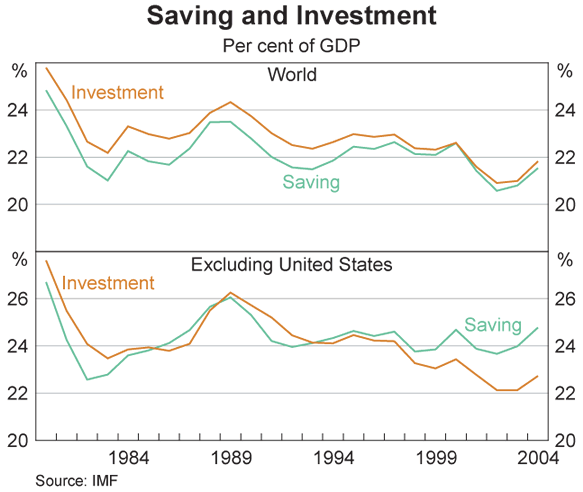
Current account deficits in the US and other English-speaking countries
The US and several developed ‘anglophone’ countries (notably Australia, New Zealand, Canada and the UK) have typically recorded current account deficits. In the US, after the sharp decline in government saving at the start of the 1980s, subsequent movements in the national saving and investment ratios tended to track each other, falling and rising by similar magnitudes in response to the recession and recovery periods of the US economy. This pattern changed from the late 1990s: while the investment ratio declined during the 2000–01 recession and then recovered, after declining steeply the saving ratio did not pick up during the subsequent economic recovery. As a consequence, the US current account deficit has widened significantly (Graph 3).

The current account positions in the rest of the anglo area have recently started to diverge (Graph 4). As in the US, the current account deficit in Australia has widened, reaching 6½ per cent of GDP in 2004. New Zealand has experienced a similar trend. In contrast, in the UK the current account deficit has been little changed since the late 1990s (2 per cent of GDP in 2004) while in Canada, after successive years of large deficits, the current account has been in surplus since 1999 (reaching 2.2 per cent of GDP in 2004).
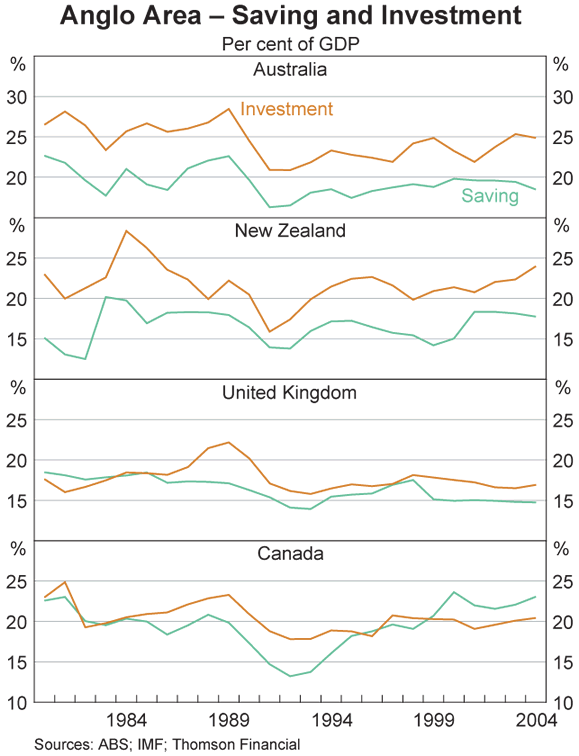
The overall saving and investment data for these countries can be disaggregated to show the net saving of the household, business and government sectors (defined here as the excess of saving over investment for each sector).[6] Net household saving has gradually declined during the period under review, falling by a broadly similar magnitude in all the anglo countries (Graph 5). This decline has been underpinned by rising household wealth, favourable labour market conditions and financial deregulation. In recent years, an upswing in residential investment has also been a common factor, especially in Australia and Canada. While the trend has been less uniform through time, net business saving has increased sharply in these countries since the end of the 1990s (Graph 6). This has reflected both an increase in gross business saving (by around 1 per cent of GDP in the US and between 3 to 4 per cent in the other countries) and a decline in the ratio of business investment (by around 2 per cent of GDP).
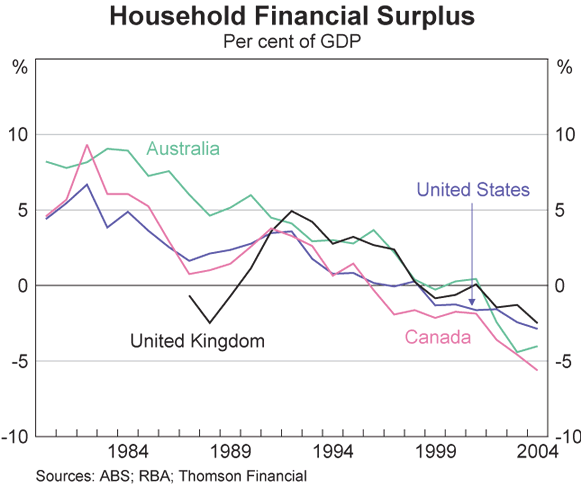
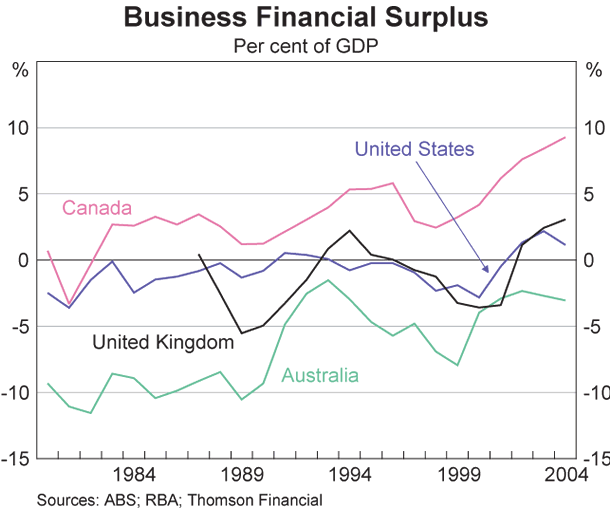
Net government saving behaviour also varied among the anglo countries during the 1980s and 1990s, but government saving in these countries was in broad balance by around 2000 (Graph 7). Since then, net government saving in the US as a share of GDP has deteriorated sharply and is now back to around its average level for the 1980 to 1995 period. In the UK, while net government saving has recently declined by a magnitude similar to that in the US, the concurrent increase in net business saving in the UK has been sufficiently large to keep the current account deficit unchanged. In contrast, net government saving in Australia and Canada have been fairly stable over recent years.
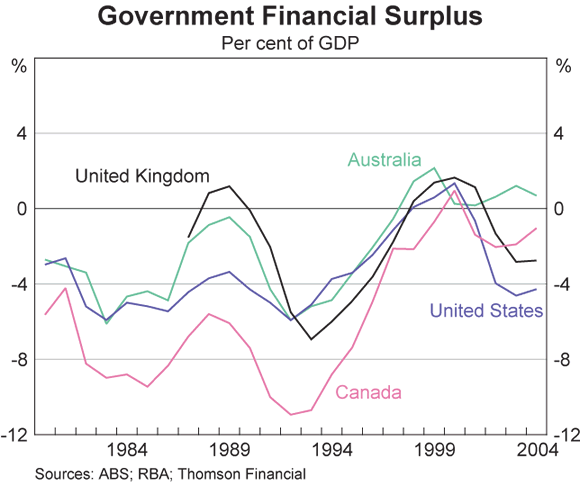
Current account surpluses in Japan and developed Europe
The deficits in the US and other anglo countries have typically been financed by surpluses in Japan and, to a lesser extent, the euro-area countries. In Japan, saving and subsequently investment increased in the 1980s, peaking at close to one-third of GDP, with the surplus averaging around 2½ per cent of GDP (Graph 8). In the 1990s, as the economy slowed and the ageing of Japan's population began to have a more pronounced effect, the investment and saving ratios fell back. Recently, investment (primarily of business) has declined faster than saving (primarily of government and households) and hence the current account surplus has increased.
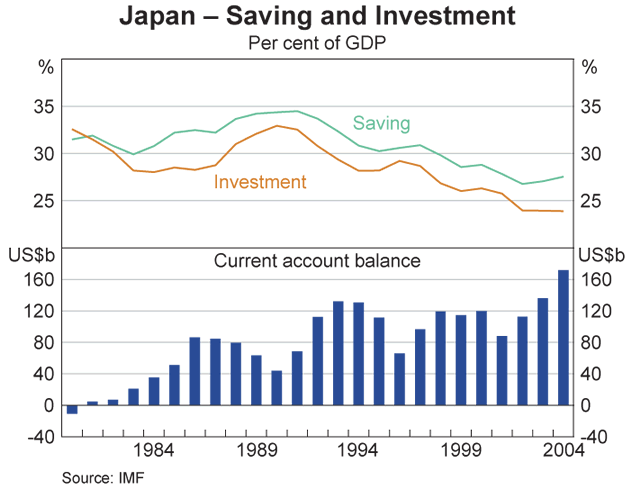
In the euro countries, apart from a brief period in the early 1990s when the German unification and single market provided a stimulus to investment, the area has recorded persistent surpluses that have averaged around ½ per cent of GDP (Graph 9). This aggregate outcome, however, masks varying trends in the large European countries. The surplus in Germany has increased by US$113 billion since 1997, mainly reflecting a large decline in household and business investment. This has been offset by increasing external deficits in France, Italy and Spain. In addition to Germany, significant net savings have been recorded in advanced European countries outside of the euro area, notably in Scandinavia and Switzerland (collectively standing at around US$110 billion in 2004).
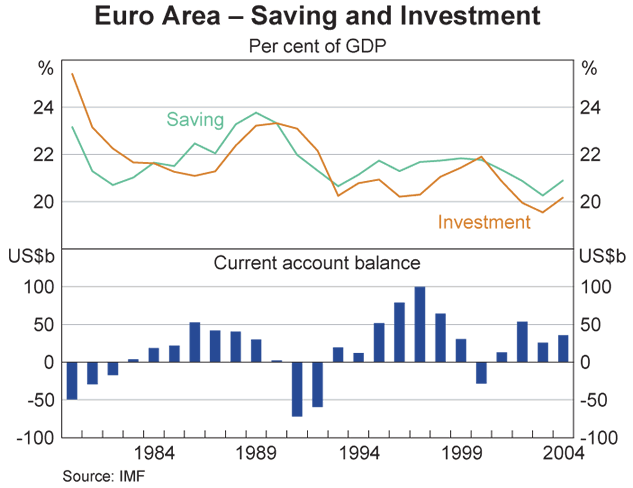
Developments in other Asian countries
Developments in other Asian countries have made an increasingly important contribution to the changes in international financial flows. For much of the period, China had only a small effect. In the 1980s and the first half of the 1990s, the national saving and investment ratios in China increased gradually and roughly commensurately, and the current account remained in broad balance. During the Asian crisis in 1997–98, the investment ratio fell back and hence the current account surplus started to widen (Graph 10). But between 2000 and 2004, the investment and saving ratios increased rapidly, with investment (primarily of business) rising by 9½ per cent of GDP and saving (primarily of business and government) by an even larger 12 per cent of GDP. The surplus widened, reaching US$69 billion in 2004, double its 1997 level.[7] The IMF projects China's current account surplus will widen further, to reach US$115 billion in 2005 (over 6 per cent of GDP).
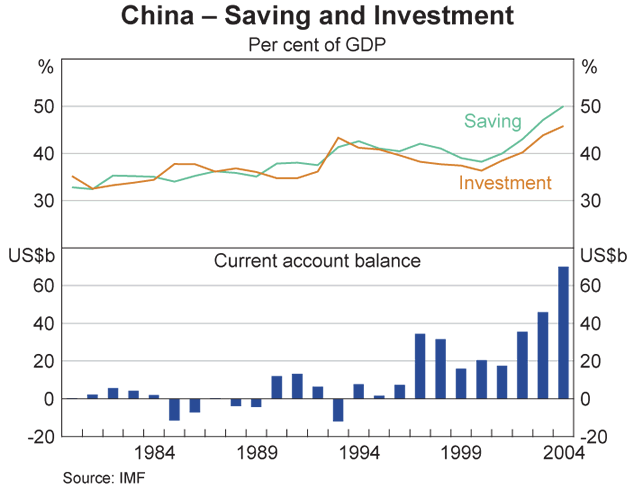
In the rest of Asia, saving and investment patterns have also changed substantially in recent years, although in ways that differ markedly from those in China. After averaging 26 per cent of GDP in the first half of the 1980s, the investment ratio increased rapidly from 1986, reaching 33 per cent of GDP by the mid 1990s. While the saving ratio also increased, it rose at a more gradual pace than the investment share, and hence the region's current account position changed from a surplus in the 1980s to a deficit in the order of 3 per cent of GDP by the mid 1990s (Graph 11). The investment ratio declined sharply during the Asian crisis, falling to 24 per cent of GDP, and staying at about that level thereafter. But, unlike the investment ratio, the savings ratio has declined only modestly since the Asian crisis period. As a consequence, the region has recorded current account surpluses of around 4 per cent of GDP since the late 1990s (US$115 billion in 2004).
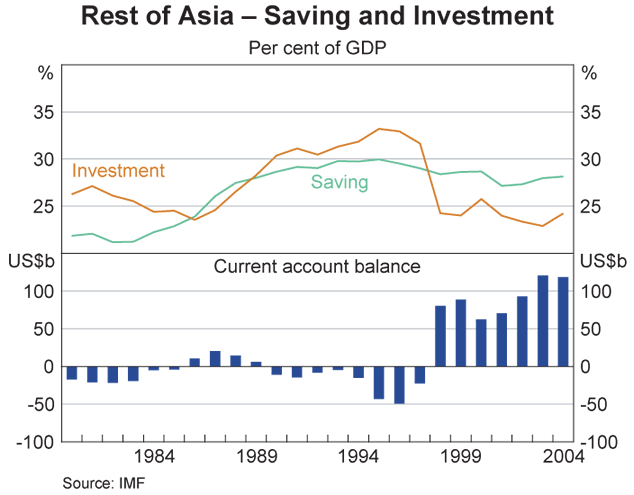
Other developing regions
Other developing regions have also started to record current account surpluses. In the oil-producing nations in the Middle East and Russia, net saving has typically increased immediately following a rise in the world oil price, but subsequently fallen back as domestic demand picked up and/or the price of oil declined. After initially recording large current account surpluses in the early 1980s when oil prices were high, the region subsequently moved into deficit as the oil price and saving ratio declined. Given the recent increase in oil prices, the region has again become a large net supplier of saving (Graph 12). Indeed, assuming oil prices remain at present levels, the surplus of this region is projected by the IMF to rise to over US$300 billion in 2005, which would make it the largest supplier of net saving to the world.
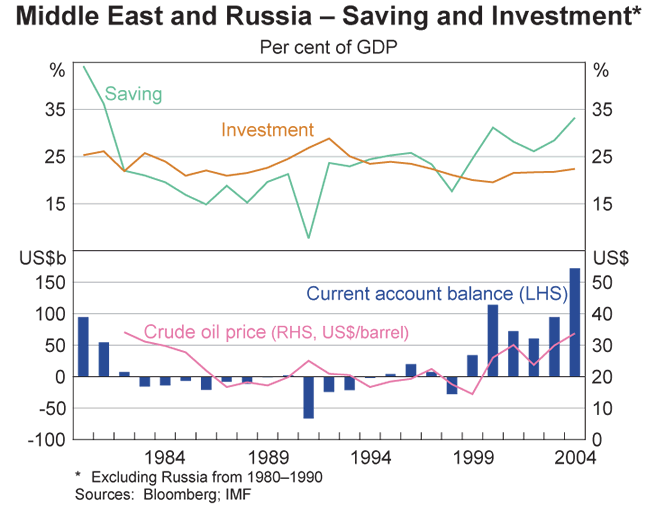
Finally, the Latin America region has traditionally recorded a current account deficit that reached 4½ per cent of GDP as recently as 1998 (Graph 13). Thereafter, while the investment ratio has declined gradually following the economic difficulties in Argentina and Brazil in 2001–02, the saving ratio has increased sharply (led by the government sector) and the current account now shows a small surplus. This development leaves the Eastern Europe and former Soviet Union (excluding Russia) region as the only emerging market area still to show a current account deficit (around US$47 billion in 2004).
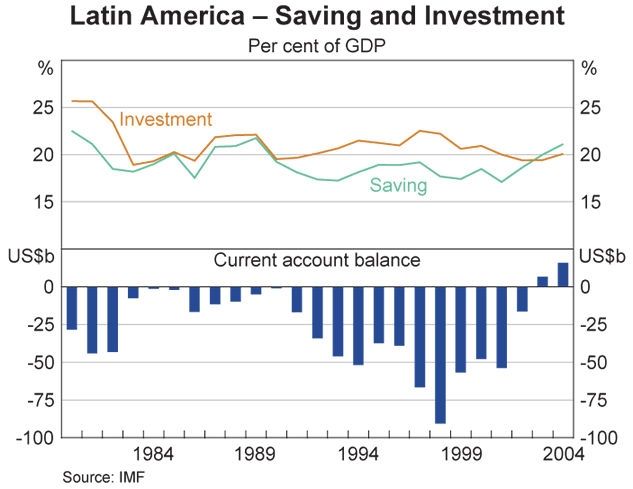
Conclusions and Outlook
The recent patterns of world financial flows have been exceptional. By 2004, only a few major countries still had a current account deficit – with the US, some other English-speaking countries, and the former communist countries (excluding Russia) the notable exceptions – while the number of countries that have a current account surplus has increased. Furthermore, the magnitude of the international flows has grown, with larger surpluses generated by Japan, other Asian countries and the oil producers financing a larger current account in the US.
Given their present magnitudes, continued substantial increases in these current account deficits and surpluses seem unlikely to be sustained over the medium term. That said, the nature of the adjustment mechanism and its timing are difficult to predict. Efforts to reduce the current account deficit in the US would likely have to focus on fiscal consolidation. However, a reduction in the size of the US budget deficit would be unlikely to have a major impact on the size of the current international flows unless accompanied by adjustment in the surplus countries, where the outlook varies considerably. Specifically, in Japan, while the ageing population could lead to further declines in domestic investment over the medium term, the saving share will likely also fall as people retire. Given the high level of government debt, Japan will also eventually have to undertake a period of fiscal consolidation. The future impact on the size of Japan's current account surplus in the near and medium term will depend on which of these trends dominates. In the euro area, near-term trends in the region's current account surplus will in large part depend on whether Germany, as the largest economy in the area, successfully addresses the factors that are constraining its domestic consumption and investment. Nonetheless, reform is likely to have only a gradual impact on the saving and investment ratios in Germany.
Turning to the other countries, for some regions there are reasons to believe that the present surpluses could start to decline in the foreseeable future. While large surpluses in the oil-producing nations will continue in the near term if oil prices remain high, in the medium term they are likely to decline as domestic consumption and investment respond to the increased terms of trade that these countries have experienced. In addition, given the investment opportunities in the Latin America region, the IMF forecasts that its current account surplus will start to decline by 2006.
The outlook for the large current account surpluses in non-Japan Asia is more uncertain and will depend critically on the policies adopted in these countries. High levels of saving appear to reflect a cautious approach by governments and residents in response to the Asian crisis, which has been constraining consumption demand across the region. Investment activity has varied, with high levels recorded in China but relatively subdued activity in the rest of Asia. Wide-ranging policy reforms, including more flexible exchange rates, better social security arrangements, and structural and financial sector reforms could over time increase domestic consumption and investment spending in these countries and reduce the size of their current account surpluses.
Footnotes
This article was prepared by David Orsmond of Economic Analysis Department. [1]
See, for instance, Bernanke B (2005), The Global Saving Glut and the U.S. Current Account Deficit, speech at the Sandridge Lecture, Virginia Association of Economics, Richmond, 10 March. Available at http://www.federalreserve.gov. [2]
Even the Sub-Saharan Africa region recorded a (small) current account surplus in 2004. [3]
The current account balances for all countries and regions should sum to zero. However, when adding the balances of all countries reported in the IMF's World Economic Outlook database, a persistently negative global current account balance results, implying recorded world investment exceeds recorded world saving. This statistical discrepancy, which has narrowed over time to around ¼ per cent of world income, is mostly due to measurement errors. More generally, the quality of the saving and investment data, collected from national sources and the IMF, are for some countries subject to significant measurement error. [4]
To derive the world and regional averages, individual country saving and investment data are measured in US dollars, converted using the current exchange rate at the time, and then summed to form the regional totals. This concept reflects the availability of funds from one region for another at any point in time. To derive the regional aggregates shown in the World Economic Outlook database, the IMF weights the saving and investment data by GDP as measured by a country's estimated purchasing power parity (PPP). In this measure, the world saving and investment ratios have increased in recent years, primarily reflecting the high PPP weight of China, where saving and investment levels have increased sharply. [5]
Gross saving data by sector for New Zealand are not available, but other evidence suggests New Zealand's recent experience has been broadly similar to that of Australia. [6]
In recent years, China has also experienced large capital inflows linked to speculation in regard to appreciation pressures on the renminbi. The large increase in China's official reserves in 2004 – over US$200 billion – primarily reflected the official policy to keep the external value of the renminbi fixed to the US dollar. For an expanded discussion of this issue, see Macfarlane IJ (2005), Payments Imbalances, Speech to the Chinese Academy of Social Sciences, Beijing, 12 May. Available at <http://www.rba.gov.au>. [7]